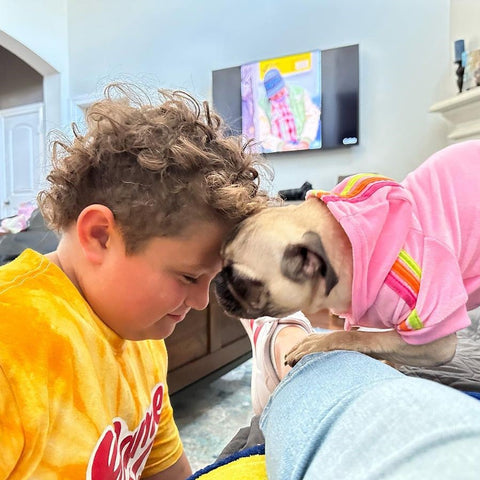Understanding Dog Behavior: A Guide to Canine Body Language
Dog behavior is a fascinating subject. Just as humans communicate with words and gestures, dogs showcase their unique dog behavior through body language. While they can't talk to us with words, their dog behavior shows many different feelings and thoughts.
By understanding these signals, we can foster a deeper bond with our furry friends and ensure their well-being. This guide helps explain the small signs that show how dogs feel.
Ears & Dog Behavior
One of the first things to notice in dog behavior is the position of their ears. Dogs have diverse ear shapes, from floppy to pointed. A relaxed dog will have its ears in a natural position.
When alert or feeling dominant, the ears rise, indicating a change in dog behavior. Observing the ears can provide quick insights into a dog's current state of mind.

Instagram: billie_elfrenchie
Eyes and Dog Behavior
A dog's eyes are a clear window to its dog behavior. Soft eyes with a relaxed gaze indicate contentment.
In contrast, direct staring can be a sign of dominance or threat, a crucial aspect of dog behavior to understand. The eyes, often called windows to the soul, can reveal a lot about a dog's intentions.

Instagram:lambi_yorkie_girl
Mouth Expressions & Behavior
Much like humans, a dog's mouth can reveal a lot about their dog behavior. A relaxed mouth resembles a gentle smile, while tensed lips or a tight mouth indicate stress.
Observing the nuances of a dog's mouth can help in predicting their next move or mood.

Instagram: bowiebojack
Jack Russell enjoying outdoors in sun protection tee
Jack Russell enjoying outdoors in sun protection tee
Body Posture in Dog Behavior
The tension in a dog's muscles, especially around the head and shoulders, can provide insights into their dog behavior.
A calm dog will have a smooth coat, while an anxious one might raise its hackles, a clear sign of defensive dog behavior. A dog's posture can often be a precursor to its actions, making it a vital aspect to monitor.
 Instagram: ms.mochie
Instagram: ms.mochieTail Talk & Behavior
The tail is a significant indicator of dog behavior. An excited dog wags its tail quickly, while a nervous one has a slower wag.
Recognizing these tail movements is essential in understanding dog behavior. The speed, direction, and position of the tail can offer a comprehensive view of a dog's emotional landscape.

Instagram: 0810.ponpongram
Observing Dog Behavior Signals
It's crucial to consider various signals in tandem to get a holistic understanding of a dog's behavior. For instance, a dog might wag its tail but also show signs of tension, indicating mixed emotions in their dog behavior.
By piecing together these signals, we can paint a more accurate picture of a dog's feelings.
Human Influence on Dog Behavior
Our body language can significantly influence dog behavior. Rapid and jerky hand movements can make a dog anxious, showcasing the interconnectedness of human actions and dog behavior.
It's a reminder that our actions, intentional or not, can have profound effects on our canine companions.
 Instagram: elliebeanrescuepug
Instagram: elliebeanrescuepugComfort & Behavior
Clothing can influence a dog's behavior. Many owners see a positive change in their dogs when they wear comfortable clothes, especially in cold weather. A snug sweater or pajamas can help a dog feel relaxed, while ill-fitting clothes might cause distress.
Watching how your dog reacts to clothing can tell you about their comfort. Proper attire not only keeps them happy but also promotes positive behavior, enhancing the bond between you and your pet.

Instagram: kodakz.of.koda
Understanding dog behavior takes time and patience. Every dog is different, but with regular observation, you'll learn to read their signals better. Building a bond with our dogs takes time and understanding. By learning their behavior, we improve their well-being and our connection.
Communication with our dogs is mutual. As we learn about them, they also watch and react to us, leading to a closer bond.














